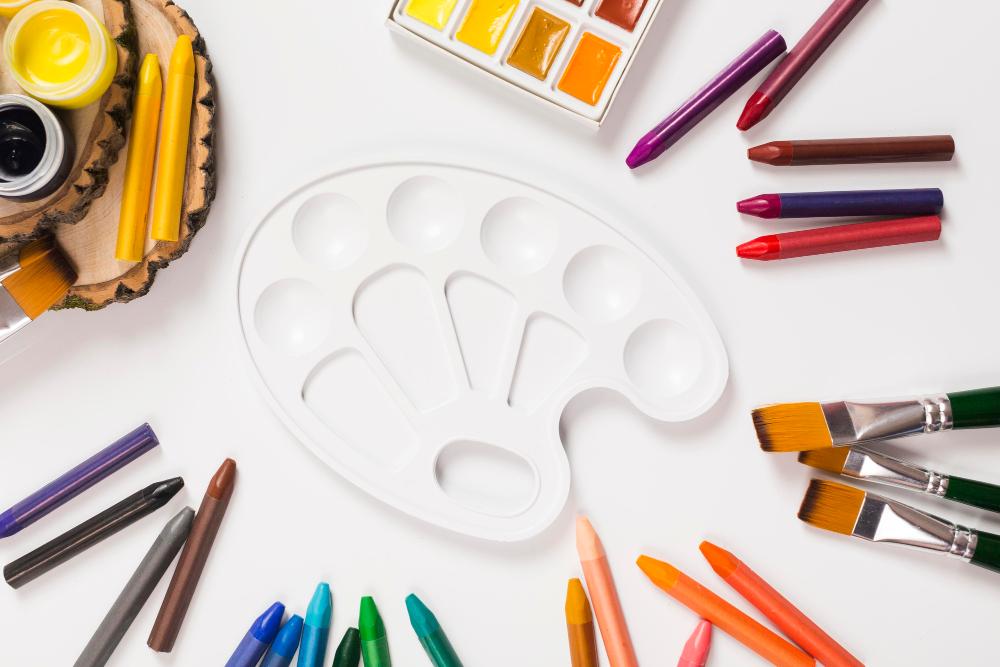Art education plays a vital role in shaping the holistic development of students in schools. Beyond just learning about colors and shapes, art education fosters creativity, critical thinking, and emotional intelligence among students. In this blog, we will explore the importance of art education in schools, particularly in the context of higher secondary schools in Thrissur, and how it contributes to inclusive education in the region.
Why Art Education Is Important in Schools?
1.Promotes Creativity and Innovation:
Art education encourages students to think outside the box and express themselves creatively. Through activities such as drawing, painting, and sculpting, students learn to explore new ideas, experiment with different techniques, and innovate solutions to problems. This creative thinking is essential for success in various fields, including science, technology, engineering, and mathematics (STEM).
2.Fosters Emotional Intelligence:
Art education provides a safe space for students to explore and express their emotions. Through art-making, students can process and communicate their feelings, develop empathy towards others, and build healthy relationships. This emotional intelligence is essential for social and emotional well-being, as well as for navigating the complexities of interpersonal interactions.
3.Cultivates Cultural Awareness:
Studying art is an immersive journey that transcends boundaries, opening up a kaleidoscope of cultural richness to students. Through the exploration of various artistic expressions, students embark on a voyage that unveils the intricacies of different societies, traditions, and worldviews. From the vibrant hues of African tribal paintings to the delicate strokes of Japanese calligraphy, each artwork serves as a window into the soul of its creators and their cultural milieu.
As students delve into the narratives behind famous artworks and the lives of renowned artists hailing from diverse backgrounds, they develop a profound sense of cultural empathy and understanding. This heightened cultural awareness nurtures tolerance, compassion, and respect for the multitude of human experiences, fostering a tapestry of inclusivity and harmony in society. By embracing the mosaic of global cultures through art, students not only enrich their own perspectives but also contribute to the creation of a more interconnected and compassionate world.
4.Supports Academic Achievement:
Research has shown that students who participate in art education perform better academically across all subjects. Engaging in art activities stimulates brain development, improves cognitive function, and enhances memory retention. Furthermore, it encourages interdisciplinary learning by integrating concepts from various subjects, such as history, science, and literature.
5.Encourages Collaboration and Communication:
Art education often involves collaborative projects where students work together to create artworks. Through collaboration, students learn to communicate effectively, share ideas, and negotiate differences. Collaborative art projects foster teamwork, leadership skills, and a sense of community among students. By working together towards a common goal, students develop important interpersonal skills that are essential for success in school and beyond.
6.Provides Therapeutic Benefits:
Art has therapeutic benefits that can help students cope with stress, anxiety, and trauma. Engaging in art activities provides a form of self-expression and relaxation, allowing students to release emotions in a healthy and constructive way. Art therapy techniques, such as drawing, painting, and sculpting, can help students process difficult experiences, build resilience, and improve overall mental health. Incorporating art therapy into school curricula can support students’ emotional well-being and contribute to a positive school climate.
7.Prepares Students for the Creative Economy:
In today’s rapidly changing world, creativity and innovation are highly valued skills in the workplace. Art education prepares students for the creative economy by fostering creativity, adaptability, and problem-solving skills. Through art-making, students learn to think outside the box, adapt to new challenges, and generate innovative ideas. These skills are essential for success in industries such as design, advertising, technology, and entrepreneurship. By nurturing creative talents and fostering an entrepreneurial mindset, art education equips students with the skills they need to thrive in the 21st-century workforce.
8.Promotes Environmental Awareness:
Art education can also promote environmental awareness and sustainability. Through art projects focused on environmental themes, students learn about the importance of protecting the planet and preserving natural resources. Art can be used as a tool for advocacy and activism, raising awareness about environmental issues and inspiring positive change. By creating artworks that address environmental challenges, students become stewards of the environment and agents of social change. Art education empowers students to use their creative talents to make a positive impact on the world around them.
9.Celebrates Personal Growth and Achievement:
Finally, art education celebrates personal growth and achievement among students. When students create artworks, they experience a sense of pride and accomplishment in seeing their ideas come to life. Art exhibitions, showcases, and competitions provide opportunities for students to share their work with others and receive recognition for their talents. Celebrating students’ artistic achievements boosts their confidence, self-esteem, and motivation to continue exploring their creative potential. It celebrates the unique talents and contributions of every student, fostering a culture of creativity, excellence, and lifelong learning.
The Role of Art Education in Inclusive Education in Thrissur
Inclusive education aims to provide equal opportunities for all students, regardless of their background, abilities, or differences. Art education plays a crucial role in promoting inclusivity in schools in Thrissur by:
Celebrating Diversity: Through art, students can celebrate their unique identities and express their individuality. It embraces diversity and encourages students to explore their cultural heritage, traditions, and beliefs. By valuing and respecting differences, art education promotes inclusivity and creates a sense of belonging for all students.
Accommodating Different Learning Styles: Art education offers a variety of activities and teaching methods that accommodate different learning styles and abilities. Whether students are visual learners, auditory learners, or kinesthetic learners, art education provides opportunities for every student to excel and succeed. This inclusive approach ensures that no student is left behind and that all students have the chance to thrive.
Creating Accessible Learning Environments: Art classrooms are often equipped with adaptive tools and materials that make learning accessible to students with diverse needs and disabilities. From tactile materials for students with visual impairments to adaptive tools for students with physical disabilities, art education creates inclusive learning environments where every student can participate and contribute.
Conclusion
In conclusion, art education plays a crucial role in schools, particularly in higher secondary schools in Thrissur, by promoting creativity, critical thinking, emotional intelligence, and cultural awareness among students. Additionally, art education contributes to inclusive education in Thrissur by celebrating diversity, accommodating different learning styles, and creating accessible learning environments for students of all abilities. By recognizing the importance of art education and prioritizing its integration into school curricula, educators can empower students to become lifelong learners and engaged global citizens.
AlsoRead: Illustration Essay writing





Leave a Reply